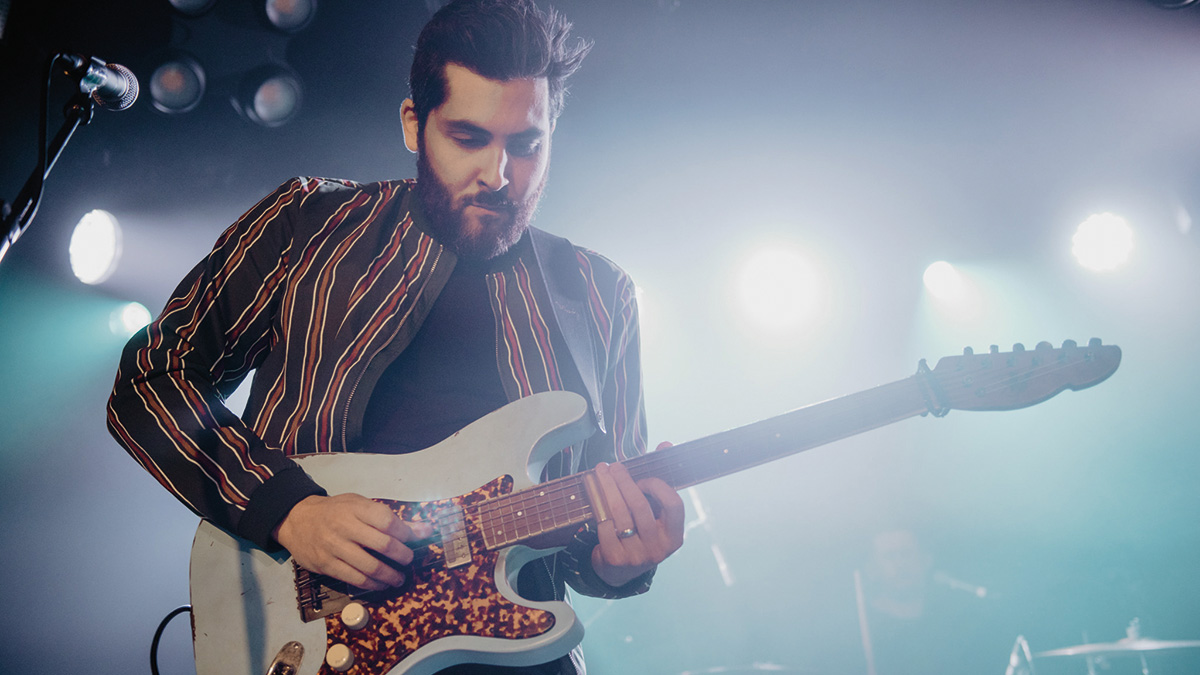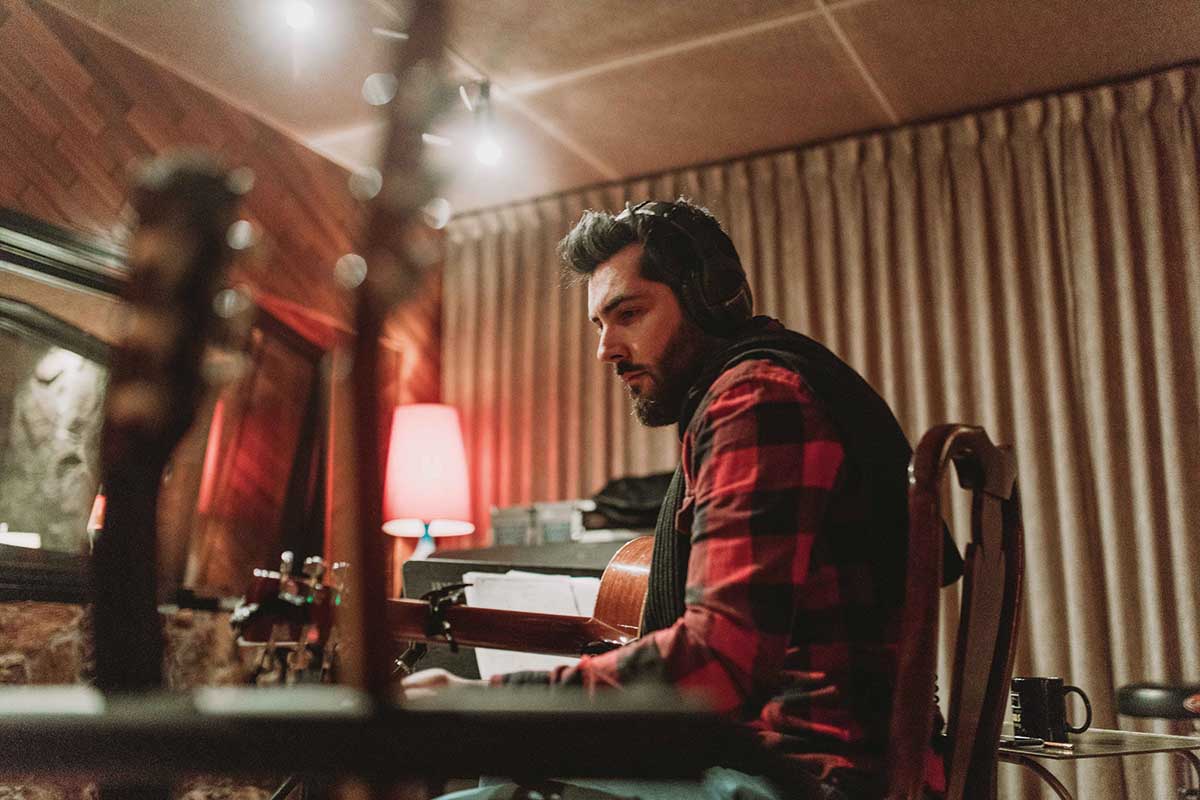Ariel Posen Unpacks the Gear Behind the Tones on His Breathtaking New Album
On 'Headway,' the Canadian guitar genius makes the instrument a tool for ideas.

Attend a live show or seek out certain videos featuring Canadian guitarist Ariel Posen (especially the one with him playing Billy Preston’s “Nothing From Nothing”) and you will witness slide and single-note sleight-of-hand that leaves your jaw on the floor.
You can get a taste of this on Posen’s version of John Martyn’s “Angeline,” from 2019’s live-in-the-studio Familiar Ground. You’ll find less evidence of that monster soloist on his official studio records, including Headway, his latest, self-released album.
But these days, when shredders abound on YouTube, Headway, like Posen’s first album, offers something that is in shorter supply. On those outings you will find a player who crafts perfect guitar parts and tones that serve as both foundations and finishing touches to original tunes, rife with singable melodies, gorgeous vocal harmonies, and foot-tapping grooves.
That’s not to say there are no guitar pyrotechnics. Most songs do feature solos: a pointed slide through an octave fuzz interlude in “Heart to Heart,” a brief explosion on “Coming Back,” more slippery goodness on “Nobody Else,” and a teaser fade jam on “I’m Gone.”
As we talk, Posen reveals his philosophy of when and where to pull out all the stops, as well as how he puts guitars in their place both conceptually and sonically.
When and where did you record the new record?
We recorded it in December 2019 at Stereobus in Winnipeg, the same studio as the first record. I wanted to keep the same core team of co-producer, engineer, and studio.
Is it fair to say you sometimes approach your songs almost as your own sideman?
I think you have to be like that. I’ve made a living playing live and recording for other bands and artists. When we did my first record, How Long, I had this underlying anxiety of not knowing what I was supposed to be doing.
This time around I had a lot more experience as an artist and was more comfortable. I treated it more like other sessions. It’s not a guitar record. Guitar is just the tool that I use to get all my ideas out.
How has your gear or sound changed since the first record, if at all?
It hasn’t changed too much. I played a Mule StratoMule a lot that I didn’t have on the first record. Otherwise, it was much the same gear: my 335-style Josh Williams, my Collings 360 LT M, my Fender Jazzmaster, a resonator, some acoustics, and a Two-Rock amp.
The effects and tools were basically the same, but how they were recorded was where we got a little more creative. I made sure every electric track had a room mic going. We sometimes used the room mic as a boost to lift a section or a solo.
It’s interesting you say that, because on “Sometimes You Lie,” the solo does sound like there’s room ambience on it.
What you’re primarily hearing is my Jazzmaster into the Two-Rock with a fuzz and plate reverb, but you’re also hearing a lot more room than on the rest of the tracks. The room almost acts as a natural breakup, even though it’s not really breakup – it’s just hearing from afar. I also doubled it completely clean, which gives it a bit more body and headroom. I did that on a few of the solos.
Is your Jazzmaster a Fender?
It’s a Masterbuilt Carlos Lopez. I hadn’t really messed with Jazzmasters until I played one on tour in the U.K. a couple of years ago. It’s so different. It occupies its own sound space. It’s very bright, but for recording it sits perfectly in a mix.
Is it in one of your tunings or standard?
I have it in C. Tuning it down makes it bigger and growlier, but it’s still very bright. If it was in standard tuning with.010s or .011s, it might be too bright. I told them not to put a treble bleed in, so when you turn it down to eight or seven it gets warmer and cleans up. The rhythm circuit is unbelievable. It’s all over the record.
On “I’m Gone,” it sounds more like an actual slap delay than room ambience.
It is. All the slap was on the pedalboard. I primarily used the Eventide H9 or the Chase Bliss Tonal Recall.
Am I correct that you run those pedals into the front of the amp, not in the loop?
Correct. I don’t do effects loops. The Two-Rocks have so much headroom, and if I’m in open D or tuning down to baritone range, I need that to maintain body. I don’t want it to be compressing or breaking up.
I run the amp clean with one overdrive on and get my clean sound from rolling the guitar volume down a little. I would often use my signature Broadcast AP pedal, which is the ultimate recording pedal. I had it set to very low gain.
I think that the less gain there is, the fuller and bigger it sounds. Everyone thinks you need to add more gain, but that just makes it sound smaller. You lose the punch that headroom provides. The highly overdriven things that you hear on the record are primarily fuzz. It is much more dynamic that way. It also depends on the guitar. The lower the pickup output, the better.
Do you remember which fuzz you were using?
I had about five fuzz pedals with me, so I could try different colors. I might want something more spitty or more pillowy. I had two King Tone mini fuzz pedals, a germanium and a silicon version; a couple of the DanDrive fuzz pedals; and the Isle of Tone Haze 67. On some songs I experimented with putting the fuzz at the end of the chain and a modulation effect before it.

On “Now I See,” it sounds like you’re using modulation on the solo. Would that have been one where you put the modulation in front of the fuzz?
There was no fuzz on that. That’s a Leslie preset on the H9. It would have either been a Duelist or Broadcast overdrive, and then the modulation, with my Josh Williams Mockingbird guitar.
“Did You See It Coming” has some interesting guitar sounds in the background. What were you doing on that?
At the very end of the song, where that undulating sound keeps going, I hit a big chord. My co-producer was holding my phone, which had the H9 app open to whatever the sound was.
He modulated the X/Y parameters in real time like a human expression pedal. For me, it’s all about textures. If you have too much of one sound, none of the sounds will pop out. It’s about finding a place for each sonic region.
I am a guitar player. I do not try to run away from that fact. However, I’m not looking to put out guitar music
You’ve done two records of great midtempo songs with gorgeous harmonies and beautiful melodies. Having seen you play the Billy Preston song “Nothing From Nothing” live, I can attest you are a monster improviser, and a big part of your YouTube following is into your virtuosic guitar playing. Would you consider doing a record in the future that’s more guitar-oriented?
I am a guitar player. I do not try to run away from that fact. However, I’m not looking to put out guitar music. My music is very guitar-driven. There are cool sounds, parts, and solos in basically every song.
If you want to hear me stretch out on some solos, come see a show. I like to save that for a live element because it doesn’t translate as well on a record. I want the record and the live show to be two separate things. That said, I’ve been working on some projects that are more guitar-oriented that I’m very excited about.
- Headway is out now.
Get The Pick Newsletter
All the latest guitar news, interviews, lessons, reviews, deals and more, direct to your inbox!
"This 'Bohemian Rhapsody' will be hard to beat in the years to come! I'm awestruck.” Brian May makes a surprise appearance at Coachella to perform Queen's hit with Benson Boone
“We’re Liverpool boys, and they say Liverpool is the capital of Ireland.” Paul McCartney explains how the Beatles introduced harmonized guitar leads to rock and roll with one remarkable song










